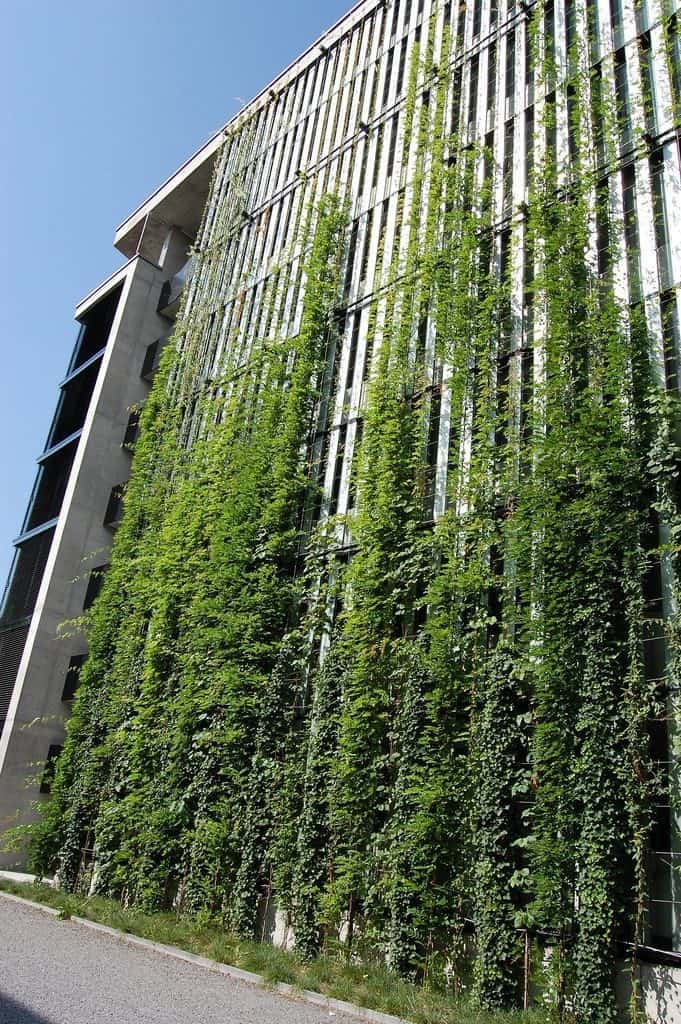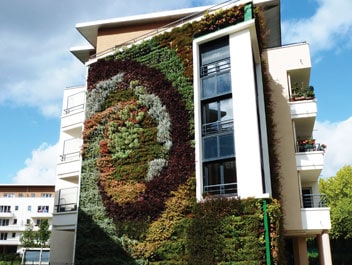Living walls can increasingly be seen everywhere – in shopping centers, hotel lobbies, high rise buildings, art galleries, private homes and co-workspaces. For growers with limited horizontal space for gardening, vertical gardens are a real lifesaver because they can be grown on a vertical surface, thus saving the horizontal flat surfaces for living or work space. As New York living wall installers we are very interested in the effects of vertical greening systems on the city environment.
Vertical gardening transforms the aesthetics of our landscape. Once upon a time, the concept of gardening up was a style related to people living in the city who reside in mansions with hidden balconies. Fast-forward a decade and vertical gardening is widely used all over the world. Even people with large gardens would like to add an extra dimension to their outdoor space with vertical gardening. It is also used by large companies that organize events and want to create a striking discussion topic.
The following paragraphs we will explore some techniques of having plants on a wall and how they relate to living walls specifically.

Green façade
A green façade is created by the growth of climbing plants on the facade of a building, either from plants that are grown in garden beds at the base, or by planting pots at different levels of the building. Climbing plants can be attached directly to the surface of a building or be supported by a structure that is independent of the building. The use of climbers anchored to a structure by twisting rods or tendrils, makes it possible to install a green façade for solid walls or other structures to create a bulkhead, sunshade or screen. The density of the facade cover can be managed to fit the required function. For example, a façade designed to shade a wall of a building should have a higher leaf density than a screen installed near a window designed to allow at least a partial view of the surroundings beyond the façade.
Direct green facades
Self-clinging climbing plants such as Virginia creeper, Boston ivy and climbing Hydrangea are planted in the ground or in containers next to the building. The plants climb onto the façade by attaching roots or pistons directly to the wall surface. Sometimes this kind of climbers can cause structural damage to the building. Irrigation is carried out with an irrigation system at the plant roots or by natural processes.
Indirect green facades
Vines, tendril climbers and leaf-twining climbers are planted in the ground or in containers next to the building. Suitable plants include vines such as Wisteria (Wisteria sinensis), Hops (Humulus lupulus), Honeysuckle (Lonicera) and Morning glory (Ipomoea hederacea) and climbers such as vines (Vitis), passion flower (Passiflora) and ampelopsis (Ampelopsis brevipedunculata). The plants climb on the facade by attaching their tendrils or leaf stem to pre-stressed steel or stainless steel wire. Irrigation is carried out with an irrigation system at the plant roots or by natural processes.

Living Walls
Living walls differ from the above techniques in that the plants of a living wall actually live on the wall. They don’t grow up the wall. The roots are actually on the wall. There are several ways to do this. One is to place the plant roots in felt pockets. Another way is to use trays. A third popular way, and our favorite, is to use a growing medium like rock wool or coconut fiber where you plug the roots into.
Whatever system you use for a living wall, the irrigation is always from above via irrigation lines. The water is supplied via a timer, usually once or twice a day. The benefit of living walls over the facades mentioned above is that the effect is immediate. Once you install the plants your wall is complete. You don’t have to wait for the plants to grow up the wall like you do in a facade.
The other benefit is you can design the plants in visually striking ways. With a facade it is very hard to control how the plants grow up the wall. With a living wall the plants grow where you place them, and they can be placed in countless ways to make different designs.
Benefits of vertical greening systems
The use of vertical greening systems on new and existing buildings can offer multiple environmental benefits and offer a sustainable approach to energy saving, the management of nutrients and water and the effective preservation of buildings. This applies to facades and living walls alike.
The environmental and ecological benefits of green roofs are well studied and include improving air quality, reducing pollution, increasing biodiversity and reducing the heat island effect in urban areas. Likewise these benefits can be seen in facades and living walls.
The leaves of the plant collect and absorb the fine dust particles and transform the carbon dioxide produced by traffic and heating into carbon hydrates and oxygen. The reduction of the thermal island effect in urban areas is due to the lower amount of heat returned by the green facades and the moisture that is affected by evaporation caused by plants compared to artificial surfaces. This process indirectly also saves a considerable amount of energy supplied to the building, because the plants and the growing medium provide insulation and shade that can reduce the energy required for cooling.
Vertical greening systems improve biodiversity because they create a habitat for micro-organisms and also for smaller animals such as bats, bees, birds, etc. Green facades function in this context as a source of food (insects) and as a possibility to nest or to breed.
In addition to the aforementioned benefits, green roofs and facades also offer economic benefits. These relate to the real estate market, more sustainability of buildings and a better psychological state of the citizens.
The presence of vegetation in urban areas can influence the economic value of buildings, increase the prices of real estate or rent by improving the aesthetic aspects. Green roofs and vertical green systems reduce the frequency of maintenance interventions by protecting the leaves against the negative effects of UV rays, temperature fluctuations, acid rain and air pollution on the underlying surfaces.
Nevertheless, vegetation and green spaces are rare in modern urban environments where impenetrable surfaces, such as traditional building materials, paved roads, etc., can cover more than 75% of the total area. It is recommended that most urban areas are green because some of the environmental benefits of greening the building envelope only work if a large part of the area is green.

